Let the states set migrant intake: Morrison
States would submit their skilled migrant needs and prove they had sufficient infrastructure under a plan to rewrite how permanent migration levels are set.

States and territories would have to submit to the federal government their annual requirements for skilled migrants and prove they had sufficient infrastructure, under a plan to fundamentally rewrite the way permanent migration levels are set by the commonwealth.
The Australian understands that the policy has been discussed at senior levels of the Morrison government following increasing demands from the states for a greater say in national population policy amid community concerns about urban congestion and declining quality of life.
The new framework being proposed would shift the onus for determining the permanent migration intake from the commonwealth government to the states and territories, with national settings determined by an aggregate of all the states and territories’ needs.
If agreed to it would constitute a fundamental shift in immigration policy to reflect a more demand-driven model for the annual permanent intake.
But the states would be required to prove they had begun work on the plans for infrastructure, such as housing approvals, and work on schools and hospitals, to cope with the numbers.
Amid calls for the annual immigration number to be cut, the federal government under the direction of Home Affairs Minister Peter Dutton has already overseen a fall in the annual permanent intake from a high of 190,000 a year under the former Labor government to 162,000 last year. This has returned the annual intake to pre-Labor era levels of more than a decade ago.
It is understood that while the proposal is in the early stages of development, cabinet is likely to approve tonight the creation of a population taskforce to provide recommendations on other policies as part of a broader population plan.
The Australian revealed in August that Population and Urban Infrastructure Minister Alan Tudge, who held the multiculturalism and citizenship portfolio before the leadership spill, was close to finalising a change to immigration settings that would apply geographic conditions on skilled migrants, forcing them to settle in regions or cities outside of Melbourne and Sydney for a minimum of five years.
The proposal to amend the way the intake is set, however, would go further and address one of the fundamental problems in population policy — the commonwealth government in control of one of the main population levers, immigration, and the states being responsible for dealing with infrastructure issues such as schools, hospitals and roads.
The Australian understands that while the mechanisms have not yet been decided upon, significant work has been done, with Scott Morrison heavily involved, having had input to the initial policy process as treasurer.
The states, in particular NSW, have demanded a greater say in setting the immigration rates, claiming they have had to bear the burden of high population growth which was outstripping their ability to build infrastructure.
NSW Premier Gladys Berejiklian had demanded that population policy be put on the agenda for the next Council of Australian Governments meeting, having sought to shift the blame for concerns about increasing urban congestion in Sydney back to the federal government’s migration settings.
“It’s time to tap the brakes and take a breather on immigration levels to this state,” the Premier said last month.
NSW Treasurer Dominic Perrottet has also sought to shift the focus away from the state government’s shortcomings in infrastructure to federal immigration settings.
Mr Perrottet demanded that the NSW government have a role in Australia’s immigration intake.
He described the immigration debate started by his Premier as a “critical juncture in our state’s history” and criticised the federal government’s pro-immigration approach, saying it missed the point and “merely adding more people isn’t a sustainable economic strategy”.
The Prime Minister two weeks ago flagged a potential rewriting of immigration policy by bringing the states into the process when he said he would be developing a “ground-up” approach to population settings.
“Instead of doing a top-down approach, what I’m doing with the states and territories now is saying, ‘you tell me how many people you can accommodate in your state and around your state’, and our immigration numbers will be based on how many people those states can support with the infrastructure and services they can provide,” the Prime Minister said in a radio interview with 2GB host Alan Jones.
Mr Tudge has also recently flagged a policy shift when it came to the migration intake, claiming there were cities and centres outside Sydney and Melbourne that were claiming to be in need of more skilled migrants.
He said the fact that almost 90 per cent of new permanent arrivals to Australia were settling in Sydney or Melbourne was unsustainable.
Bill Shorten called on Mr Morrison last month to support a bipartisan expert taskforce to develop a new settlement program.
Australia’s population passed 25 million in July, which was 20 years earlier than predicted in the first intergenerational report in 2002.
The Opposition Leader said there needed to be bi-partisan agreement on a set of recommendations, including annual immigration rates, infrastructure needs, and delivery of health and education services as well as greater scrutiny of temporary work visas.
Mr Morrison and Tony Abbott were at loggerheads earlier this year, when as treasurer Mr Morrison dismissed the former prime minister’s claims that the annual intake had to be virtually cut in half to address the urban congestion burden placed on major metropolitan centres.
A joint Treasury and Department of Home Affairs study released earlier this year revealed a significant economic dividend from skilled migration.



